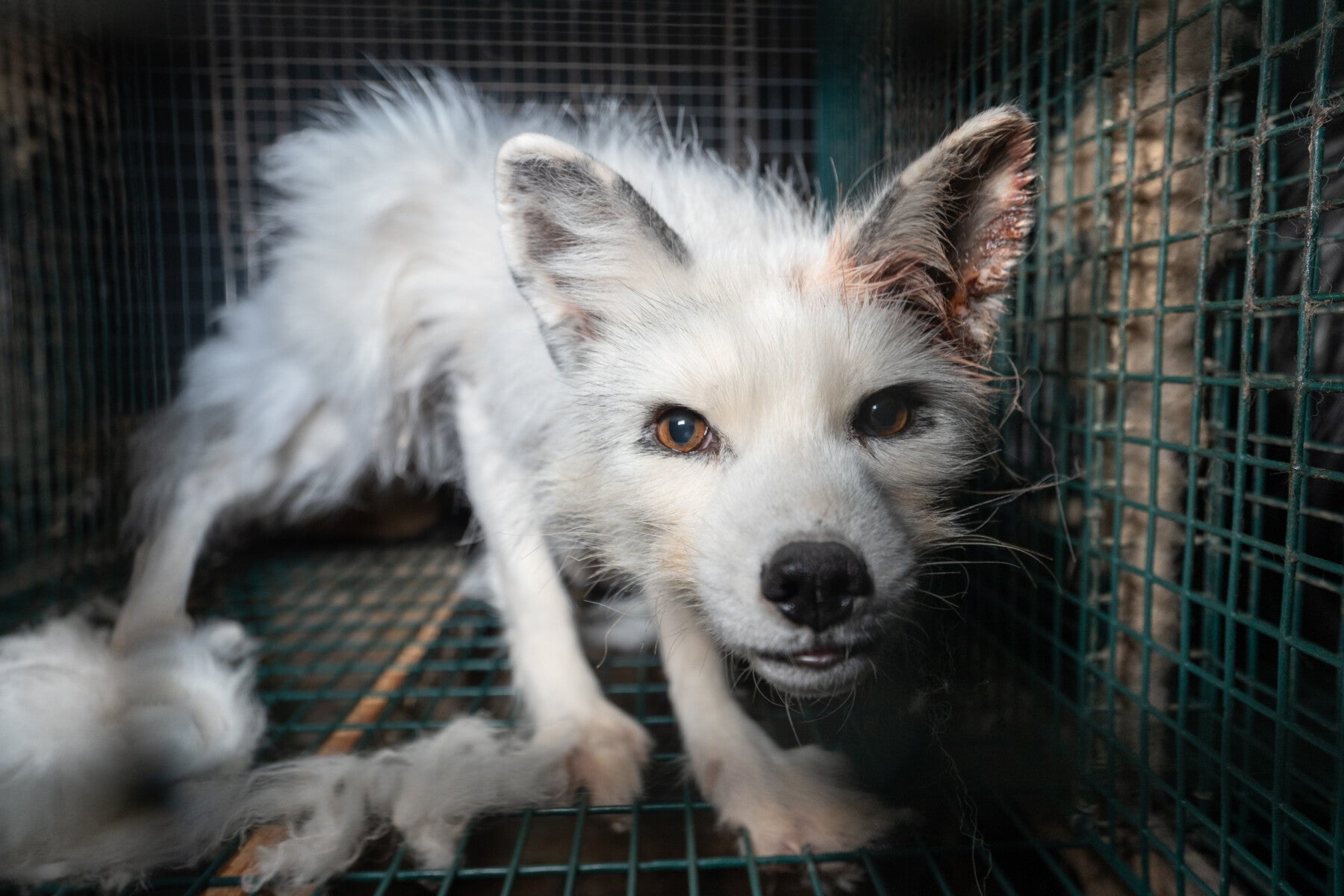
How many animals are killed globally on fur farms?
Each year, tens of millions of animals are bred and killed to supply the fashion industry with not only traditional fur coats but, increasingly, real fur trim for hooded jackets, and real fur pompoms used on hats, gloves, shoes and a range of other clothing and accessories. It’s estimated that as many as half of all animals raised for their fur are killed to satisfy the market for fur trim.
The industry has seen a decline in recent years, as consumers, retailers, designers turn their backs on real fur, and politicians vote in favour of fur production bans and, increasingly, fur sales bans.
Annual fur production:
- 2014: Europe 43.6m, China 87m, North America 7.2m, Russia 1.7m
- 2018: Europe 38.3m, China 50.4m, North America 4.9m & Russia 1.9m
- 2021: Europe 12m, China 27m, North America 2.3m & Russia 600,000
- 2022: Europe 10m, China 22m, North America 2m, & Russia 600,000
(Figures shown are estimates focused on mink, foxes, raccoon dogs, chinchillas and sables. Rabbits and animals trapped for their fur are excluded.)
What about trapping in the wild?
In addition to fur farming, many millions of animals are trapped and killed for their fur in the wild. Most fur from wild-trapped animals comes from the USA, Canada and Russia. In 2018, almost 3 million animals were killed for their pelts by trapping in North America, including 647,000 raccoons and 363,000 coyotes. Traps inflict great pain and anguish, both to the target animals and to unintended victims such as pets and endangered species.
Often left for days, unable to seek shelter, food or water, these animals can cause serious injury to themselves in an attempt to escape. When the trappers finally arrive, they will often stomp or beat the animals to death. We exposed the brutality of trapping animals for fur in an undercover investigation, in collaboration with Born Free USA.
Have any countries banned fur farming?
Yes, over the past two decades, 25 countries have either voted to ban the practice, have prohibited the farming of particular species, or have introduced stricter regulations that have effectively curtailed the practice. The Canadian province of British Columbia has also banned the farming of mink for their fur. Several other countries, including Romania, are also discussing the introduction of bans on fur farming. See the latest list at furfreealliance.com/fur-bans.
Have any countries banned fur sales?
Yes, in 2021 Israel became the first country in the world to ban real fur sales. In the United States, California became the first US state to ban the sale of fur in 2019 (the ban came into effect in January 2023) following similar bans in cities including Los Angeles, San Francisco, Berkeley and West Hollywood. To date, 16 towns and cities in the United States have banned fur sales and more US cities and states are looking to follow suit in the future. In the UK, the government is considering action on fur sales.
Is fur farming cruel?
Yes. Animals bred for their fur such as foxes, rabbits, raccoon dogs and mink are confined in small, barren, wire cages for their entire lives. Unable to express their basic natural behaviours such as digging, roaming large territories and, for semi-aquatic mink, swimming and diving, these naturally active and curious animals have been shown to display the stereotypical behaviour of mental distress such as repeated pacing and circling inside their cages. Such confined spaces can also result in animals self-mutilating and fighting with their cage mates.
Numerous recent investigations at so-called certified “high welfare” mink, fox and raccoon dog farms in Finland have revealed a catalogue of deplorable conditions and distressing suffering, including over-sized “monster foxes,” animals with open wounds, deformed feet, diseased eyes, and even incidents of mink being driven to cannibalism. HSI has also exposed the conditions suffered by chinchillas on fur farms in Romania and the plight of baby foxes, mink and raccoon dogs in China.
How are animals on fur farms killed?
When their pelts are at their prime, before they are one year old, the animals are gassed, electrocuted, beaten or have their necks broken. In December 2015 HSI filmed foxes on a Chinese fur farm being beaten to death, and rabbits being given a blow to the head before being shackled from their back legs and their throats cut before being skinned. Instances of raccoon dogs being slammed against the ground then skinned whilst still showing signs of consciousness have also been documented in China. (Warning, graphic footage)
See the evidence for yourself: Take a look at HSI’s investigation at a fox and raccoon dog fur farm in China, and our investigation at a rabbit fur farm in China, both December 2015. Warning: graphic footage.
Which designers and retailers are fur-free?
Increasingly, international designers, brands, department stores and luxury online retailers are turning their backs on cruel real fur. In recent years, Max Mara, Gucci, Prada, Chanel, Moncler, Dolce & Gabbana and Versace have gone fur free, as has well-known former-fur-using brand Canada Goose – to name just a few! By supporting fur-free designers, we can all help to put the business of animal cruelty out of fashion. For a full list, check out the Fur-Free Retailer website at furfreeretailer.com.
